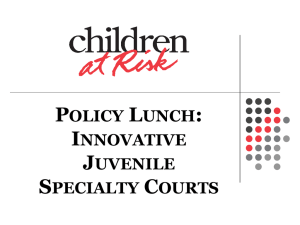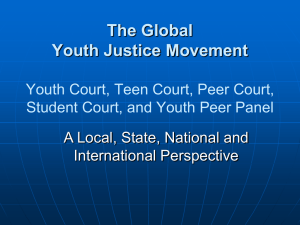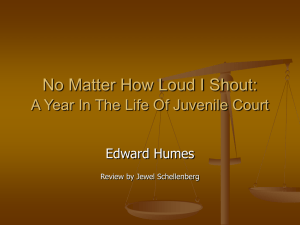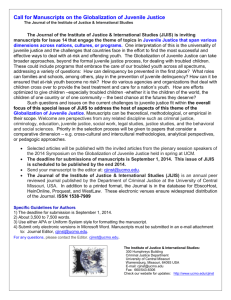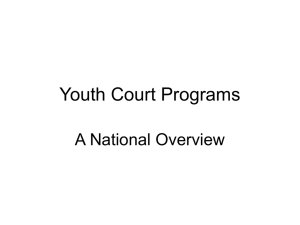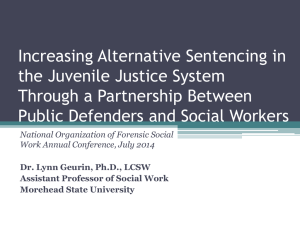Empowering Families For Success: Best Practices in Dependency
advertisement
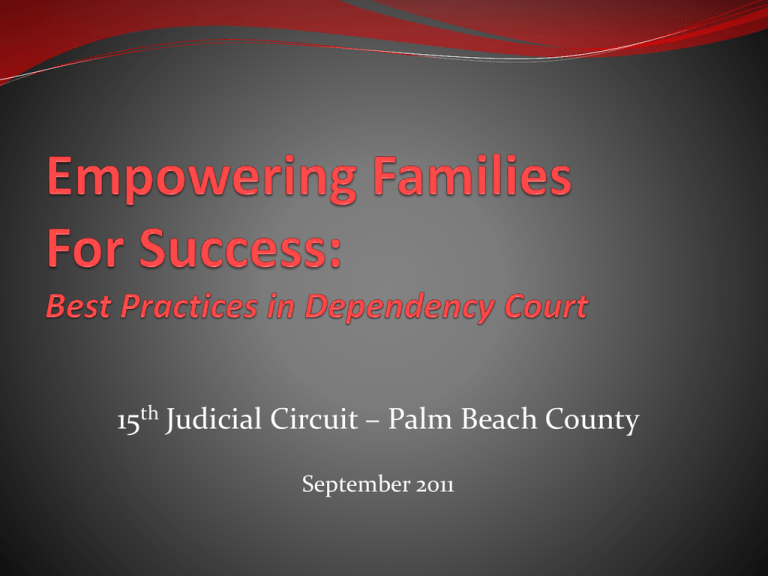
15th Judicial Circuit – Palm Beach County September 2011 Objectives Learn about innovative approaches to working with families in Dependency Court Understand how to design and structure systems of coordination and collaboration Identify benefits of multi-system collaborations Identify strategies and tools to help implement similar programs Who We Are Mary Quinlan, LCSW Mental Health Operations Manager Cristy Altaro, MA Juvenile Alternative Sanctions Coordinator Kathy Sanchez Juvenile Court Case Manager Angela Bess, Ed D Court Education Liaison Program Manager th 15 Circuit – Best Practices Family Drug Court Crossover Case Management Independent Living Court Court Education Liaison program What We’re Doing A 12 month, 5 phase specialty court for parents in dependency court where substance abuse is the main reason for the removal of the children Phase 1, CHOICE Family Group Conferencing, Assignment of Family Intervention Specialist and Case Manager Substance Abuse Assessment within 72 hours Weekly court appearances Daily AA/NA meetings Begin inpatient or outpatient treatment Frequent random drug testing Obtain a sponsor Phase 2, CHALLENGE Continued Treatment Weekly court appearances Daily AA/NA meetings Frequent random drug testing What We’re Doing – cont’d. Phase 3, COMMITMENT Phase 4 and 5, COMMENCEMENT AND SELF RELIANCE Continued Treatment (inpatient typically moving to outpatient) Bi-Weekly court appearances Daily AA/NA meetings Frequent random drug testing Continued Treatment Moving into aftercare Monthly court appearances Daily AA/NA meetings Frequent random drug testing SANCTIONS AND INCENTIVES ARE USED THROUGHOUT THE PROGRAM Why It’s Necessary There is a more elaborate support system for families while ensuring child safety There is heightened judicial oversight of children and families Family Drug Court parents are motivated to get treatment they would otherwise not receive Family Drug Court parents are more likely to enter treatment, spend more time in treatment, and are more likely to complete treatment than parents in comparison groups Parents are more likely to be reunited with their children. Source: FDC: A National Evaluation, Children and Family Futures (OJJDP) Technical Assistance Program A Team Effort Grant for Family Drug Court written with input from stakeholders Judge Kathleen Kroll, Administrative Judge of the Juvenile Division championed the effort and became the FDC Judge Committees were formed to design the court, write the policies and procedures, identify community resources, develop an advisory board A Drug Court team was identified and traveled together to observe Miami’s Dependency Drug Court How It Helps Data Collection: FDC vs. Control Group CONTROL= 20 clients PERMANENCY Reunifications: TPR: Perm. Guardianship: TIME FRAMES Time to Treatment: Average Time to Reunification : FAMILY DRUG COURT = 18 clients PERMANENCY Reunifications: TPR: Perm. Guardianship: 6 families 0 families 0 families 30-45 days TIME FRAMES Time to Treatment: 20 days 8.5 months Average Time to Reunification : 4 families 3 families 2 families 6 months Challenges Achieving buy-in from all the stakeholders, esp. the parent's attorneys Instituting Family Group Conferencing Availability of Treatment Beds Availability of Affordable Housing Differing views on procedural issues: diluted drug screens, sanctions, reunification What We’re Doing A coordinated, collaborative approach for early identification and notification of youth involved in the delinquency and dependency systems Specific, written identification and notification procedures Specialized crossover dockets Why It’s Necessary Various “players” Separate silos Inadequate communication Avoid a duplication of services Streamline the court process A Team Effort Formation of a committee and develop stakeholder buy-in Numerous meetings to achieve success: Creation of an Administrative Order Implementation of an Memorandum of Understanding Written procedures Identification of Points of Contact for each agency How It Helps Early identification of crossover youth Increased communication relating to these youth Reduction in duplication of services Specialized hearings including delinquency and dependency players Earlier intervention Challenges Initial definition of “crossover” - vague Out-of –county, diversion, direct file, etc. Addressing confidentiality Different goals for different committee members Length of time from formulation of committee to implementation What We’re Doing The purpose of the Independent Living Court program is to evaluate a youth’s progress in developing independent living skills and take the necessary steps to help the youth obtain his/her goals. Four Juvenile Judges hold specialized Independent Living Court dockets every other week for youth over age 16 in foster care for 6 months or more Why It’s Necessary To ensure youth exiting the foster care system are provided every opportunity to become self sufficient and achieve the goals they have identified for their future. Due to the fact that placements often change the longer a child is in care, these youth are especially at risk of falling through the “cracks” and not receiving the services they need to thrive on their own. A Team Effort Our Current Chief Judge Peter Blanc spearheaded the effort to start an Independent Living Court and piloted the first ILR when he was in the juvenile division. A committee was formed and traveled to Tampa to observe their Independent Living Court In addition to Legal Aid and our CBC Agency, a local agency, Vita Nova, joined the effort to serve as specialized ILR case managers How It Helps Enhanced judicial oversight to ensure youth’s needs are being adequately addressed Vocational and educational goals are reviewed and any previously assigned tasks are followed up with to ensure compliance Most importantly, it allows the youth to voice his/her concerns and become engaged in the decision-making process Challenges Initial identification of youth eligible for Court Procedures for getting case on the docket and cancelling other judicial reviews Handling judicial reviews when an ILR child has younger siblings Timely filing of reports The Program Court Education Liaisons (School District employees) are housed in the juvenile courthouses for immediate access to information, increased collaboration and improved services for court-involved youth Program staff: (1) Program Manager (4) Education Liaisons – one assigned to each juvenile Judge Officially began in April, 2008 How We Made It Happen Former Chief Judge Kroll spear-headed an initiative to increase the collaboration between the Court system and School District A large committee was formed, followed by several smaller subcommittees to identify needs and address education-related issues School District made a commitment to this issue and allocated personnel to expand the level of services provided to court-involved youth The Many Benefits… Provide updated information and interpretation of educational records to the Court Conference with youth/families to review student needs, educational options and requirements Work with the schools on matters concerning registration, re-enrollment and transition Improved relationship between the Courts and School District, especially HS and MS Principals Assist with specialty Courts/programs What the Judges Say “An invaluable resource from providing instantaneous information on grades, conduct, classes, etc., to assisting children to get back to or into school, the appropriate school, to obtaining a better understanding of the difficulties faced by children in the delinquency system and the school system, to explaining education options to children and their parents.” “I have been in juvenile court almost five years. From my experience these liaisons are the most effective tool I have in addressing the educational dysfunctions of the children who come before me. The correlation between educational and social dysfunction is obvious. If I can get a child back on track educationally, I have a far better chance of turning that child's life around.” Challenges Understanding the Court process (delinquency & dependency) Defining responsibilities and protocols for Liaisons Maintaining dual rules – school district vs. Court Continuous struggle to maintain program staffing levels Questions/Comments Mary Quinlan mquinlan@pbcgov.org (561) 355-1925 Cristy Altaro caltaro@pbcgov.org (561) 355-6586 Kathy Sanchez ksanchez@pbcgov.org (561) 330-1772 Angela Bess BessA@palmbeach.k12.fl.us (561) 355-3497
